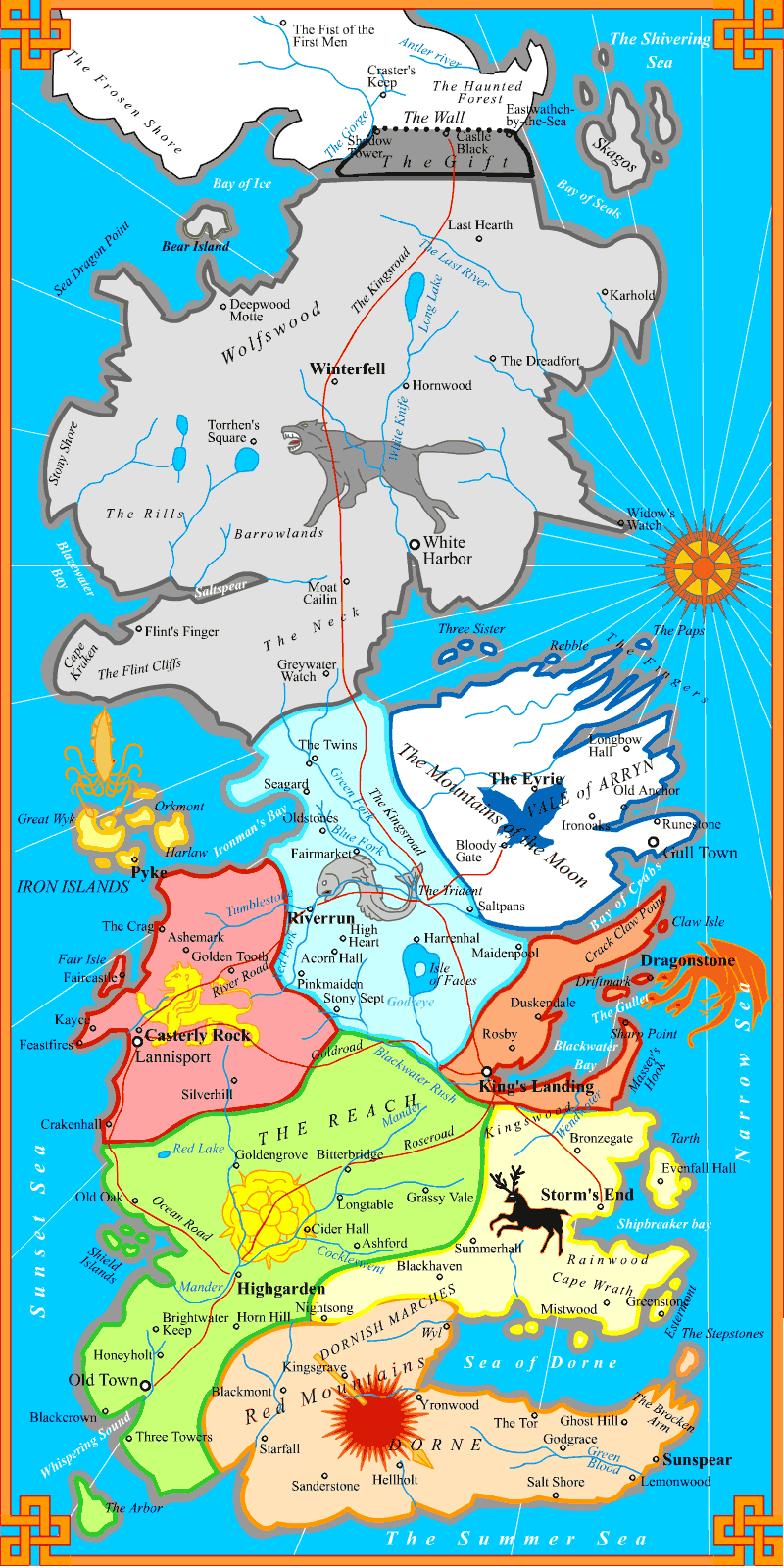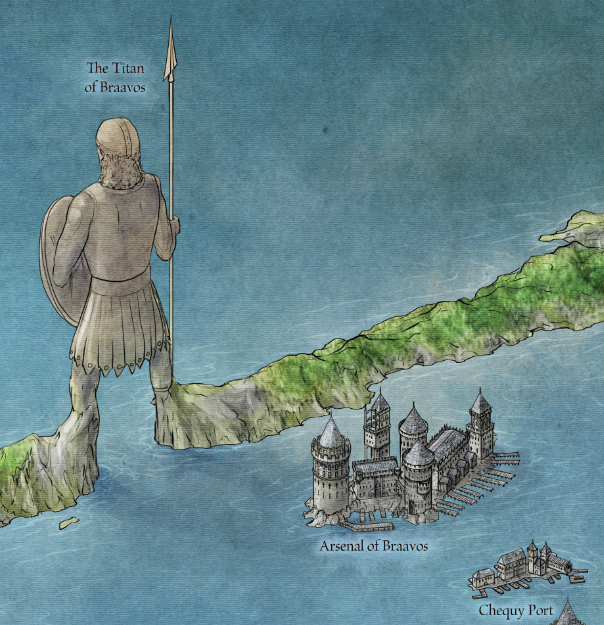 After the coming of the Andals, Westeros was split into the Seven Kingdoms. These kingdoms are simple regions today, all united under one throne, but there were seven kings in the Seven Kingdoms around -3000 AL. For the most part, the Seven Kingdoms had a peaceful existence. There was not as much in-fighting as today and very few threats from outside as well. The biggest one came during the initial split into Seven Kingdoms. The Free Folk, or wildlings, decided to unite under the Kings-beyond-the-Wall, Gendel and Gorne, to invade Westeros. Instead of going through or over the wall, an insanely huge band of wildlings broke into Westeros through an elaborate series of underground tunnels. The huge invasion looked promising, but was quickly met by the King in the North of House Stark and sent back beyond the Wall.
After the coming of the Andals, Westeros was split into the Seven Kingdoms. These kingdoms are simple regions today, all united under one throne, but there were seven kings in the Seven Kingdoms around -3000 AL. For the most part, the Seven Kingdoms had a peaceful existence. There was not as much in-fighting as today and very few threats from outside as well. The biggest one came during the initial split into Seven Kingdoms. The Free Folk, or wildlings, decided to unite under the Kings-beyond-the-Wall, Gendel and Gorne, to invade Westeros. Instead of going through or over the wall, an insanely huge band of wildlings broke into Westeros through an elaborate series of underground tunnels. The huge invasion looked promising, but was quickly met by the King in the North of House Stark and sent back beyond the Wall.
Meanwhile in Essos…
Around -700 AL, after their invasion of Old Ghis, the Valyrians began moving along the giant River Rhoyne and destroying the Rhoynish cities. Prince Garin the Great rose a 250,000 man army to attempt to stop the Valyrians, but got crushed by the force of their dragons. The Rhoynish warrior-queen, Nymeria, began to evacuate the survivors of the takeovers on 10,000 ships across the Narrow Sea. Most of the passengers were women and children. They traveled across the sea to Dorne, seeking refuge in southern Westeros. Nymeria created a marriage alliance with Mors Martell. The two finally organized the land into one kingdom, allowing House Dorne to rise as the rulers. Mors began to adopt Dornish culture, but the unification of Dorne caused problems with the kingdoms of the Reach and Storm’s End. There were many small raids and wars between these powers during this time.
While Dorne was causing problems in the South, the houses of the North had been battling each other. For over 2000 years, House Stark and House Bolton had been fighting for control of the region. House Stark finally subdued the Boltons around -700 AL and took full control of the North. Meanwhile, Karlon Stark battled raiders from the east and split off from House Stark, forming his own house of Karstark. In the west, the Ironborn of the Iron Islands rose to power. They controlled the majority of the western coast, from Oldtown and the Arbor in the south all the way to Bear Island in the North.
And back to Essos…
 Around -500 AL, the Valyrian Freehold conquered the area that now includes the southern Free Cities of Essos. The Moonsingers, a religious group, led thousands of refugees north to a mountainous region, shrouded by mist. They formed the hidden city of Braavos on a lagoon here. Later, the Titan of Braavos was built. The Titan is a huge statue just off the shore that serves as a defensive fortification.
Around -500 AL, the Valyrian Freehold conquered the area that now includes the southern Free Cities of Essos. The Moonsingers, a religious group, led thousands of refugees north to a mountainous region, shrouded by mist. They formed the hidden city of Braavos on a lagoon here. Later, the Titan of Braavos was built. The Titan is a huge statue just off the shore that serves as a defensive fortification.
More Westeros…
Around -400 AL, 300 years after being subdued, House Bolton rebelled against the Starks. Four years later, they were put down again and their siege was ended. Around -350 AL, the Storm Kings expanded their territory. At this time, they ruled the Westerlands, then expanded north to take over the Riverlands, up to the Neck. The Ironborn lost most of their lands throughout this time, but not before the Ironborn king Harren Hoare begins building Harrenhal in the Riverlands. After the Storm Kings’ expansion, Westeros remained rather quiet and there was no notable fighting between the Seven Kingdoms
Once more to Essos…
 |
| Dragonstone |
The Valyrians annexed a small island at the mouth of the Blackwater Rush about -200 AL, called Dragonstone. It was named for the castle built on it, which had a tower shaped to look like dragons. The island was ruled by a little family by the name of Targaryen.
About one hundred years after this, Braavos reveals itself to the rest of the Free Cities. It eventually becomes the most powerful due to its economic power and large fleet. Ghiscari powers started to appear in the south and the cities in Slaver’s Bay became independent. The savage tribes in the middle of the continent grew bolder. The dominant tribe, the Dothraki, began more frequently raiding villages of other tribes and other surrounding areas.
The major event to close out the era before the landing was the Doom of Valyria. The reason that the Targaryens annexed Dragonstone was because Daenys the Dreamer foresaw this doom. She convinced her father to leave Valyria before something bad happened to the family. A huge earthquake hit the capital city and split the land into fragments, creating the Smoking Sea in between them all. The area is described as “demon-haunted” and rarely people will survive a trip there. Many of Valyria’s secrets, such as how to make Valyrian steel and the dragons, were destroyed along with the Freehold. Stories of the Doom state that every hill for 500 mile split open, throwing ash and smoke into the air. Hot fires burst out and engulfed everything, even the dragons. Giants holes opened and sucked palaces and cities into the center of the world. Lakes boiled or turned into acid water, mountains burst and collapsed. Fiery fountains threw molten rock into the sky. Red clouds rained dragonglass and the blood of demons. The northern lands collapsed on itself and allowed the sea to rush in. After the Doom, the Bleeding Years hit Valyria. Valyrian colonies and conquests

